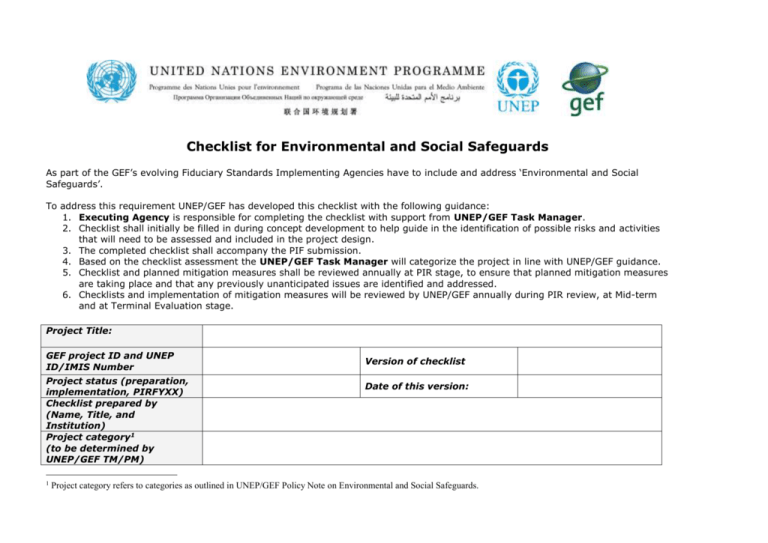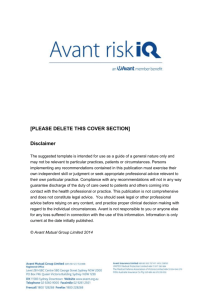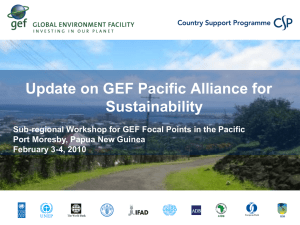Checklist for Environmental and Social Safeguards
advertisement

Checklist for Environmental and Social Safeguards As part of the GEF’s evolving Fiduciary Standards Implementing Agencies have to include and address ‘Environmental and Social Safeguards’. To address this requirement UNEP/GEF has developed this checklist with the following guidance: 1. Executing Agency is responsible for completing the checklist with support from UNEP/GEF Task Manager. 2. Checklist shall initially be filled in during concept development to help guide in the identification of possible risks and activities that will need to be assessed and included in the project design. 3. The completed checklist shall accompany the PIF submission. 4. Based on the checklist assessment the UNEP/GEF Task Manager will categorize the project in line with UNEP/GEF guidance. 5. Checklist and planned mitigation measures shall be reviewed annually at PIR stage, to ensure that planned mitigation measures are taking place and that any previously unanticipated issues are identified and addressed. 6. Checklists and implementation of mitigation measures will be reviewed by UNEP/GEF annually during PIR review, at Mid-term and at Terminal Evaluation stage. Project Title: GEF project ID and UNEP ID/IMIS Number Project status (preparation, implementation, PIRFYXX) Checklist prepared by (Name, Title, and Institution) Project category1 (to be determined by UNEP/GEF TM/PM) 1 Version of checklist Date of this version: Project category refers to categories as outlined in UNEP/GEF Policy Note on Environmental and Social Safeguards. In completing the checklist both temporary, permanent, short- and long-term impact shall be considered. Section A: Project location: Yes/No/ Description of the issue: N.A.2 Distance, direction, connection to project area and size of applicable category and other relevant criteria. - Is the project area in or close to - densely populated area - cultural heritage site - protected area - wetland - mangrove - estuarine - buffer zone of protected area - special area for protection of biodiversity In completing the checklist both temporary, permanent, short- and long-term impact shall be considered. Section B: Environmental impacts, i.e. Yes/No/ Description of the issue, e.g. quantification of impact if possible, N.A.3 necessary mitigation measures and further studies required to quantify impact, budget estimates and responsibilities for studies: - Will project require temporary or permanent support facilities? - Will project cause any loss of precious ecology, ecological, and economic functions due to construction of infrastructure? 2 The N.A. option should be reserved for projects, which do not have a specific location identified, e.g. global or regional projects with a predominantly normative scope. The N.A. option should be reserved for projects, which do not have a specific location identified, e.g. global or regional projects with a predominantly normative scope. Careful consideration of the specific issue should be exercised to determine potential impact, both short- and long-term. 3 - Are ecosystems related to project fragile or degraded? - Will project cause impairment of ecological opportunities? - Will project cause increase in peak and flood flows? (including from temporary or permanent waste waters) - Will project cause air, soil or water pollution? - Will project cause soil erosion and siltation? - Will project cause increased waste production? - Will project cause Hazardous Waste production? - Will project cause threat to local ecosystems due to invasive species? - Will project cause Greenhouse Gas Emissions? - Will project cause use of pesticides? - Does the project encourage the use of environmentally friendly technologies? - Other environmental issues, e.g. noise and traffic In completing the checklist both temporary, permanent, short- and long-term impact shall be considered. Section C: Social impacts Yes/No/ Description of the issue: N.A.4 - Does the project respect internationally proclaimed human rights including dignity, cultural property and uniqueness and rights of indigenous people? - Are property rights on resources such as land tenure recognized by the existing laws in affected countries? - Will the project cause social problems and conflicts related to land tenure and access to resources? 4 The N.A. option should be reserved for projects, which do not have a specific location identified, e.g. global or regional projects with a predominantly normative scope. Careful consideration of the specific issue should be exercised to determine potential impact, both short- and long-term. - Does the project incorporate measures to allow affected stakeholders’ information and consultation? - Will the project affect the state of the targeted country’s (ies’) institutional context? - Will the project cause change to beneficial uses of land or resources? (incl. loss of downstream beneficial uses (water supply or fisheries)? - Will the project cause technology or land use modification that may change present social and economic activities? - Will the project cause dislocation or involuntary resettlement of people? - Will the project cause uncontrolled in-migration (short- and long-term) with opening of roads to areas and/or possible overloading of social infrastructure? - Will the project cause increased local or regional unemployment? - Does the project include measures to avoid forced labour and/or child labour? - Does the project include measures to ensure a safe and healthy working environment for workers employed as part of the project? - Will the project cause impairment of recreational opportunities? - Will the project cause impairment of indigenous people’s livelihoods or belief systems? - Will the project cause disproportionate impact to women or other disadvantaged or vulnerable groups? - Will the project involve and or be complicit in the alteration, damage or removal of any critical cultural heritage? - Does the project include measures to avoid corruption? Section D: Other considerations Yes/No/ N.A.5 Description of the issue: - Does national regulation in affected country (-ies) require Environmental Impact Assessment and/or Social Impact Assessment for this type of activity? - Is there national capacity to ensure a sound implementation of EIA and/or SIA requirements present in affected country (-ies)? - Is the project addressing issues, which are already addressed by other alternative approaches and projects? - Will the project components generate or contribute to cumulative or long-term environmental or social impacts? - Is it possible to isolate the impact from this project to monitor E&S impact? 5 The N.A. option should be reserved for projects, which do not have a specific location identified, e.g. global or regional projects with a predominantly normative scope. Careful consideration of the specific issue should be exercised to determine potential impact, both short- and long-term.

![Assumptions Checklist [Word File]](http://s3.studylib.net/store/data/005860099_1-a66c5f4eb05ac40681dda51762a69619-300x300.png)








